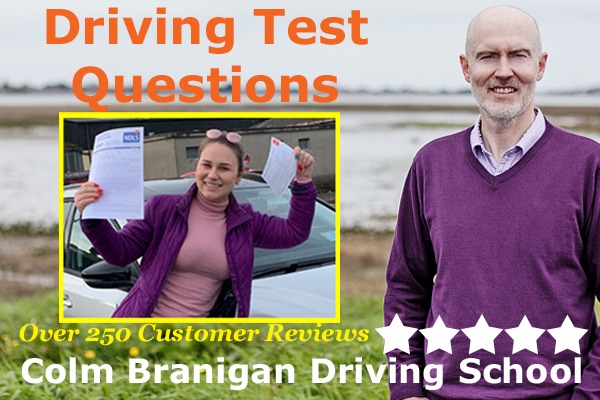Driving Test Questions
Driving Test Questions from Colm Branigan Driving School, delivering driving lessons in North Dublin since 1996.
Contact Colm Branigan Driving School on 087 6324006

Driving Test Questions
Test your knowledge in preparation for your Driving Test.
At the beginning of your driving test, you will be asked to identify a selection of road signs and to answer a selection of questions on the Rules of the Road. To help you to prepare, Colm Branigan Driving School has compiled this must-read guide of Driving Test Questions which includes some of the most common questions and answers.
Pass Your Test an Easier Way!
Contact Colm Branigan Driving School on 087 6324006
Your First 10 Driving Test Questions – Click on the Questions to see the Answers!
When can you overtake on the left?
- When you want to go straight ahead & the driver in front of you has moved out & signalled that they intend to turn right.
- When you have signalled that you intend to turn left.
- When traffic in both lanes is moving slowly & traffic in the left-hand lane is moving more quickly than the traffic in the right-hand lane.
What is meant by a solid white line in the centre of the road?
You must stay to the left & must not cross the line unless it is for access or in an emergency.
What does a broken yellow line mean?
The road contains a hard shoulder which is normally only for pedestrians & cyclists but may be used briefly to allow faster traffic to overtake as long as it safe to do so. It may also mark the edge of the road.
What does double broken white lines along the centre of the road mean?
These alert the driver to continuous white lines a short distance ahead. You must not cross them unless it is safe to do so.
At a stop sign that has no white line, where should you stop?
You must stop at the sign.
Where there is a continuous & a broken white line along the centre of the road, which one do you obey?
You must obey the line that is nearest you.
Who has priority at a roundabout?
You must give right of way to traffic already on a roundabout.
When driving, when should you dip your headlights?
- When meeting other traffic.
- When following close behind another vehicle.
- On continuously lit roads.
- In snow, fog, dusk/dawn.
- Generally, to avoid inconveniencing other traffic.
What should you do if you are dazzled by another vehicle’s headlights?
- Slow down & stop if necessary.
- Always watch for pedestrians or cyclists on the side of the road.
- If the dazzle is from an oncoming vehicle, avoid it by looking towards the left verge until the vehicle has passed.
- If the dazzle is from a vehicle behind you & reflected in your mirror, operate the night-driving mode on you mirror.
What restrictions are there in relation to the use of the horn?
Do not use a horn in a built-up area between 11.30pm & 7.00 am, unless there is a traffic emergency.
Here’s a few more Driving Test Questions!
Within what distance from the kerb should you park?
45cm
Where should you not overtake?
Near a bend, the brow of a hill, a humpback bridge, a continuous white line, where it is prohibited or unsafe to do so.
What is the sequence of traffic lights?
Green, Amber, Red.
What does a clearway mean?
No parking during specified times or stopping unless you are waiting in a line of traffic.
What rules apply to a box junction?
You must not enter a yellow box junction unless you can clear it without stopping. An exception is when you want to turn right. You may enter while waiting for a gap in traffic coming from the opposite direction as long to do so would not block other traffic that has priority.
What is the difference between a pelican crossing & a zebra crossing?
A pelican crossing is controlled by lights. A zebra crossing has flashing orange beacons & is controlled by the presence of pedestrians.
What does an island in the centre of a pedestrian crossing mean?
Zebra crossings with a central island should be treated as two separate crossings.
Pelican crossings that go straight across the road count as one crossing even if there is a central island.
If Pelican crossings on either side of the central island are not in a straight line (staggered), they count as two separate crossings.
What do the white zig-zag lines at a zebra crossing mean?
No overtaking or parking.
What is the speed limit on a) national roads (primary & secondary) & on b) motorways?
a) 100km/h
b) 120 km/h
What are the speed limits in built up areas?
Usually 50km/h unless special speed limits apply to designated roads and zones. Special speed limits are generally 30km/h or 60km/h.
What is the minimum tread depth on tyres?
Most vehicles on the road must have a minimum tread depth of 1.6mm over their main treads.
What are the rules regarding bus lanes?
A with-flow bus lane runs in the same direction as the traffic beside it & can be used by bicyclists & taxis as well as buses & is reserved during the times shown on the information plate.
A contra-flow bus lane is reserved only for buses, which means no other traffic may use it day or night.
How far away should you park from a junction?
Over 5 metres.
What position would you take up for a right turn in a one-way street?
When turning right from a one-way street, drive as close as you can to the right-hand side.
What are hatched markings?
Hatched markings are diagonal or chevron markings on the road that can be used for merging traffic, for diverging traffic & for separating traffic travelling in opposite directions (central median islands). If you see these markings on the road you must not enter the area they cover.
What does a yield sign mean?
If you see a Yield sign on the road, usually near a junction or roundabout, you must give way to traffic on a major road ahead or on the roundabout & you must not proceed unless it is safe to do so.
What is a filter light?
An arrow light, green or amber, you may proceed in the direction of the arrow if it is safe to do so.
You are approaching traffic lights & they change to amber, what action should you take?
Stop unless it is unsafe to do so.
What does a flashing amber traffic light mean?
Proceed if the crossing is clear but pedestrians have priority.
What do flashing-red lights mean?
Stop, train approaching.
Keep it going! Answer more Driving Test Questions below!
What does a continuous yellow line at the side of a road mean?
No parking during certain hours.
What do double continuous yellow lines at the side of the road mean?
No parking at any time.
Give examples of where you would not park.
Near a bend, the brow of a hill, a hump back bridge, opposite a single or continuous white line, where your vehicle would obstruct a sign, at an entrance, opposite another vehicle on a narrow road, a taxi rank, near a junction, at a bus stop, on a footpath.
Within what distance from a pedestrian crossing, should you not park?
15 metres before or 5 metres after.
What procedure must you adopt if crossing a dual carriageway with a narrow central median?
If the median is too narrow for your vehicle, you must wait until you can complete the crossing.
What are the differences between a motorway and a dual carriageway?
On motorways, exits to left only, no traffic lights, no junctions, no roundabouts, 120Kph speed limits may apply.
Who has priority at a unmarked crossroads with roads of equal importance?
Give priority to traffic on the junction & traffic approaching from your right.
What are the road markings for no entry?
A continuous & a broken white line with the words “NO ENTRY”
What would you look out for on country roads?
Pedestrians, animals, muddy surfaces, concealed entrances, slow moving farm machinery.
When being overtaken, what must you not do?
Increase your speed.
Where should you not make a u-turn?
In a one-way street, where there is a continuous white line or lines, where a sign directs you not to.
What is meant by tailgating?
Driving too close to a vehicle in front, not keeping a safe distance
What human factors can affect your driving?
Alcohol, drugs (prescription and non-prescription), tiredness & fatigue, road rage, attitude.
What is coasting (out of gear) & why is it potentially dangerous?
Coasting is when the vehicle is not being driven by the engine i.e. the clutch pedal is held down or the gear lever is in neutral. It is dangerous because it reduces the driver’s control of the vehicle.
Who is responsible for seat belts?
For passengers under 17 years of age, the driver is responsible
For passengers 17 years of age & over, the person themselves
When following the road ahead on a multi-lane dual carriageway, which lane would you normally use?
You would normally use lane 1 or the left-hand driving lane, unless road markings indicate otherwise.
What is the “2 second rule”?
Used as a measure of a safe following distance of at least 2 seconds in dry conditions, doubled in the wet and extended further in icy conditions.
Now that you have the Driving Test Questions – Choose Colm Branigan School for Driving Lessons
Pass Your Driving Test An Easier Way!
Call or Text 087 6324006

Why Choose Colm Branigan?
25 years experience
RSA Approved Driving Instructor
Award Winning Driving School
Qualified Driving Coach
RoSPA Advanced Driving Trainer
Over 250 Customer Reviews
Have you studied the Driving Test Questions?
Now Benefit from refreshingly different and innovative training!
%
Satisfaction Guarantee
%
Quality Guarantee
Over 250 Customer Reviews
He has a knack for identifying your problem areas and he provides excellent feedback and advice to fix them.
I would highly recommend Colm. He made it possible for me to get my full licence which I really needed for work.
 6 Golden Tips to Pass Your Driving Test
6 Golden Tips to Pass Your Driving Test
Study the Driving Test Questions and Answers above.
1. Relax Your Concentration!
If you force yourself to concentrate, you will become tired quickly. Devoting too much attention to routines will result in “forced concentration” and may even result in a poor drive especially during your driving test. Routines are important of course, but only if they are used appropriately. Explore with your driving instructor ways to relax your concentration during your driving lessons or use some of the ideas I have listed below.
2. Observe Naturally!
Let your observation “flow” in a natural way. Bust the myths like “show the tester that you are checking the mirrors”. If you make too many “deliberate” head movements, it’s more likely that the driving tester will fault you for poor observation. Let’s face it, if your spending too long looking in your mirrors, your general observation will have to suffer. Practise observing naturally during your pretest driving lessons and ask your driving instructor to support you by highlighting good observation and areas for improvement.
3. Take in the Big Picture!
Think about it, if your vision is low you will only take in a limited amount of the information that’s available. That means that you will have less time to deal with all the stuff that’s happening! Create more time for yourself to react. When learning to drive, ask your driving instructor to help you to scan effectively- to take in the bigger picture. If you work on this during your EDT Driving Lessons and pretest lessons, you will have a much-improved chance of passing your test first time!
4. Act Safely on What You See!
During your driving test, ask yourself “What’s the safest thing to do here?” – It sounds obvious doesn’t it? However, many driving test candidates are more concerned about what they think the tester would “like” them to do instead of acting safely on what they see. During your mock tests with your Approved Driving Instructor, practise this technique so that you are making decisions based on safe progress. Then during your driving test, repeat naturally!
5. Let Your Car Do Some Work!
Know your car! If you are using your own car or if you are hiring your driving instructor’s car for your test, know what it can do and what it can’t do! Make sure you understand the technology that’s available and use it to help you during your test. Ask your driving instructor to explain or demonstrate all the driving assistance technology that you have. Let the car do some work for you!
6. Have a Coping Strategy!
Nerves are natural but if they “take over” during your test your performance will suffer. During your driving lessons and especially during pretests and mock tests, explore with your driving instructor strategies to help you cope with test nerves. These may include pre-test mindfulness techniques and /or “mind tricks” during the test itself. These instant fixes can get you back on track quickly and help you pass. You will then be able to enjoy the independence and freedom of a full driving licence!